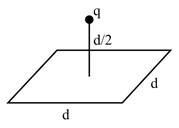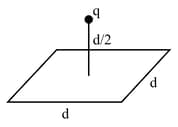EASY
12th CBSE
IMPORTANT
Earn 100
Using Gauss's law, deduce the expression for the electric field due to a uniformly charged spherical conducting shell of radius at a point inside the shell.
Plot a graph showing variation of electric field as a function of and ( being the distance from the centre of the shell).

Important Questions on Electric Charges and Field
MEDIUM
12th CBSE
IMPORTANT
State Gauss's law in electrostatics. Using this theorem, show mathematically that for any point outside the shell, the field due to uniformly charged thin spherical shell is the same as if entire charge of the shell is concentrated at the centre. Why do you expect the electric field inside the shell to be zero according to this theorem?
EASY
12th CBSE
IMPORTANT
Draw the field lines when the charge density of the sphere is (i) positive, (ii) negative.
EASY
12th CBSE
IMPORTANT
State the theorem which relates total charge enclosed within a closed surface and the electric flux passing through it. Prove it for a single point charge.
EASY
12th CBSE
IMPORTANT
An 'atom' was earlier assumed to be a sphere of radius a having a positively charged point nucleus of charge at its centre. This nucleus was believed to be surrounded by a uniform density of negative charge that made the atom neutral as a whole. Use this theorem to find the electric field of this 'atom' at a distance from the centre of the atom.
EASY
12th CBSE
IMPORTANT
Define electric flux quantity?
A point charge is at a distance of directly above the centre of a square of side , as shown in Fig. 1.163. Use Gauss' law to obtain the expression for the electric flux through the square.

EASY
12th CBSE
IMPORTANT
If the point charge is now moved to a distance ‘’ from the centre of the square and the side of the square is doubled, explain how the electric flux will be affected.

MEDIUM
12th CBSE
IMPORTANT
Use Gauss' law to derive the expression for the electric field due to a straight
uniformly charged infinite line of charge density .
EASY
12th CBSE
IMPORTANT
Draw a graph to show the variation of with perpendicular distance from the line of charge.
